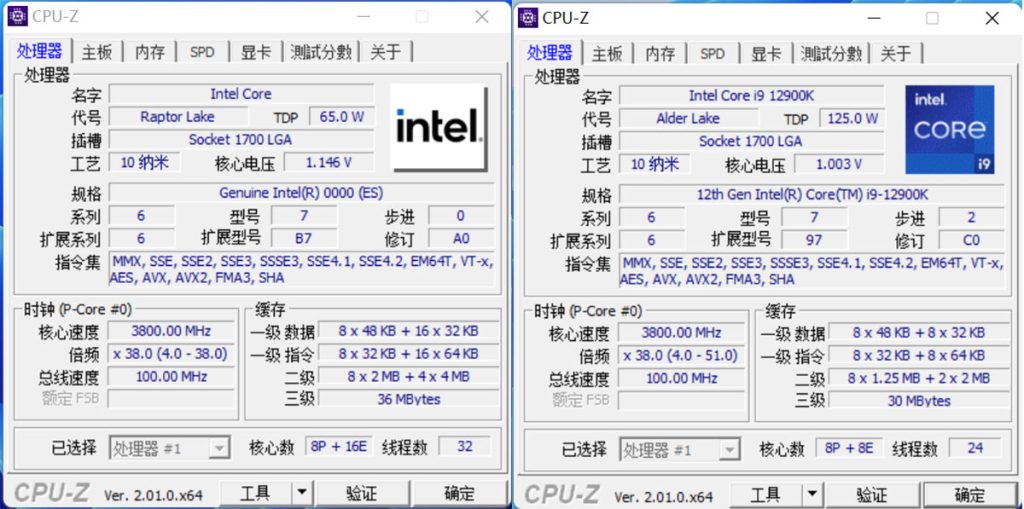A Chinese reviewer was able to get an engineering sample of the upcoming Intel ‘Raptor Lake' Core i9-13900, allowing them to test the chip well ahead of release. The engineering sample was capped at 3.8GHz, and after testing the Core i9-12900K at the same frequency, the Raptor Lake chip came out significantly ahead.
In the “review” published by Expreview (via Wccftech), you can see the configuration of the new chip. As per the CPU-Z screenshot, the Core i9-13900 will pack 8x P-cores and 16x E-cores, for a total of 24x cores and 32x threads. Each P-core has 2MB of L2 cache and an E-core cluster has 4MB of L2 cache. All summed up, that's 32MB of L2 cache and 36MB of L3 cache, corroborating the rumours that this CPU would have 68MB of L2+3 cache.

Image credit: Expreview
The reviewer ran a suite of tests to compare the Raptor Lake processor to the downclocked Core i9-12900K. Both systems were equipped with an Asus ROG Maximus Z690 Extreme motherboard, RTX 3090 graphics card and 32GB of G.Skill DDR5-5200 memory. You can see how both systems performed in the table below:
| Benchmark | Core i9-12900K (3.8GHz) |
Core i9-13900 (ES) |
13900 vs 12900K |
|---|---|---|---|
| Sandra 2021 (Integer) | 467.77 | 619.7 | +32% |
| Sandra 2021 (FP32) | 382.4 | 500.86 | +31% |
| Sandra 2021 (FP64) | 188.4 | 388.8 | +106% |
| Sandra 2021 (Multi-Integer) | 1674 | 1945 | +16% |
| Sandra 2021 (Multi-FP32) | 1807 | 2180 | +21% |
| Sandra 2021 (Multi-FP64) | 934 | 1116 | +19% |
| Sandra (Quad FP) | 42.47 | 52.8 | +24% |
| SuperPi Mod 1.9 | 9.406 | 9.969 | -6% |
| 7-Zip (Compression) | 97354 | 106536 | +9% |
| 7-Zip (Unzip) | 1271851 | 1705651 | +34% |
| 3DMark CPU Profile (1-Thread) | 823 | 756 | -8% |
| 3DMark CPU Profile (Max Threads) | 9284 | 11471 | +24% |
| x264 | 119.21 | 136.91 | +15% |
| x265 | 78.67 | 89.25 | +13% |
| Corona 1.3 | 7190450 | 9318220 | +30% |
| POV-Ray 3.7.1 | 550.09 | 497.44 | -10% |
| V-Ray | 14706 | 18281 | +24% |
| Blender | 143.71 | 181.14 | +26% |
| Cinebench R20 (ST) | 574 | 514 | -10% |
| Cinebench R20 (MT) | 8149 | 10203 | +25% |
| Cinebench R23 (ST) | 1494 | 1334 | -11% |
| Cinebench R23 (MT) | 21437 | 26748 | +25% |
| Average | +20% |
Most tests were synthetic, so these results may not represent the actual performance difference in real-world scenarios. Even so, the Raptor Lake processor is unanimously faster in multi-threaded workloads, likely due to the extra 8x E-cores. In gaming tests, the Raptor Lake ES chip was a few percentage points ahead of the Alder Lake chip.
As interesting as these scores are, final retail processors should bring different results. The engineering sample won’t have all the final optimisations in place and as we already know, the clock speed was capped below what we expect to see from retail samples.
Intel should launch Raptor Lake before the end of this year.
Discuss on our Facebook page, HERE.
KitGuru says: A 20% uplift in multi-threaded performance in a clock-for-clock comparison is a good start, but with this being an engineering sample, we expect to see different results from retail samples in the months ahead.
 KitGuru KitGuru.net – Tech News | Hardware News | Hardware Reviews | IOS | Mobile | Gaming | Graphics Cards
KitGuru KitGuru.net – Tech News | Hardware News | Hardware Reviews | IOS | Mobile | Gaming | Graphics Cards


